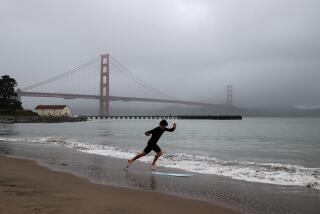Santa Monica Backs Liability Legislation : Beach Cities Seek Accident Immunity
- Share via
Santa Monica will support a new legislative offensive to overturn a 1982 appellate court ruling that prompted scores of multimillion-dollar lawsuits over injuries suffered at beaches, city officials said.
City Atty. Robert M. Myers said the city recently paid $150,000 to settle the case of a youth who was injured on a Santa Monica beach while diving into the ocean.
“The city of Santa Monica has been fortunate in not having any multimillion-dollar judgment against it,” Myers said. “It certainly doesn’t want to be in the position of Newport Beach, which had a $6-million judgment against it as the result of a surfing accident.”
It was the Newport Beach accident that prompted the renewed effort by several other beach cities to overturn the 1982 appellate court ruling, which found municipalities liable in such cases.
Battle Trial Lawyers
The previous effort was defeated last year, but the cities have pooled their resources to hire a Sacramento lobbyist to battle the California Trial Lawyers Assn. on the issue.
City Manager John Jalili said Santa Monica’s own Sacramento lobbyist will be instructed to support the measure, which was introduced last week by State Sen. Marian Bergeson (R-Newport Beach), who represents several coastal regions of Orange and San Diego counties.
“We’re very much in support of such legislation,” Jalili said.
Bergeson’s proposal is similar to one killed amid heavy lobbying by the state’s trial lawyers in 1985.
With the lawyers and their lobbyists now busy fighting a related but separate issue on the June ballot, officials in coastal cities said this year may provide their best chance ever to restore the legal immunities they enjoyed before the state Supreme Court let stand an appellate ruling in a lawsuit against the city of San Diego stemming from a 1978 drowning at Black’s Beach.
Lawyers Have Another Battle
Referring to the upcoming fight over the state’s “deep pockets” rule, which involves municipal responsibility for traffic accidents, “We would like to think their ammunition is going to be leveled elsewhere,” Bergeson said.
Bergeson became interested in the issue after Newport Beach lost a $6-million lawsuit in 1984 filed by a Claremont teen-ager who was paralyzed after he dived into shallow water and struck a sand bar.
That case relied on the appellate ruling in an earlier case filed by the children of Theresa Gonzales, who drowned off Black’s Beach in La Jolla. The justices essentially said that public entities’ longstanding immunity from responsibility for “natural conditions” does not apply in areas where improvements have been made and such municipal services as police and lifeguards have been provided.
Although Gonzales’ children settled with the city for $25,000, the case gave rise to other suits. Gonzales’ children contended that San Diego city officials had been aware for years of the unpredictable riptide conditions at Black’s Beach but had never posted warnings.
Began Posting Warnings
The San Diego ruling initially received little attention, but the Newport Beach ruling did.
Fearful that they too would be hit with large judgments, Santa Monica and other coastal cities began posting warning signs in several languages about all kinds of beach hazards--from riptides to clearly visible pier pilings.
Others, including Laguna Beach, Long Beach and San Diego, resisted posting warning signs, fearing that to do so would make them appear to admit liability in pending suits.
Bergeson said the Gonzales ruling punishes cities for “providing lifesaving services.” Because of skyrocketing insurance rates, she said, some cities might stop providing lifeguards as a way to reduce their potential liability.
John Witzel, a lobbyist for San Diego in Sacramento, said Bergeson’s bill, “watered down” since last year, “is not as strong as we would like it to be. But we’ll support it . . . as actively as we can.”
Scope of Bill Narrowed
Laguna Beach City Manager Kenneth Frank said the scope of Bergeson’s new bill was narrowed to overcome objections raised by lawyers and some of the senators who refused to support last year’s bill.
Although last year’s bill stated that unspecified improvements and services do not cancel the cities’ statutory immunity, this year’s bill is more specific, listing “lifeguards, park rangers or other persons who render services to the public.”
“We have narrowed the scope of the bill as much as we could,” Frank said. “ . . . I don’t see how anyone can oppose it.”
Still, Frank said, several beach cities are going in together to hire a lobbyist who will make the fight for the measure a top priority. He estimated that the coalition might spend as much as $25,000 on the effort.
Defending Gonzales Ruling
Bergeson said that since the previous bill was killed in the Senate Judiciary Committee, she has met with officials from coastal cities she represents and had contacts with others statewide.
Trial Lawyers lobbyist Terrence Terauchi said that organization has not yet taken a position on Bergeson’s new bill, but he indicated that he “will certainly oppose any effort to overturn the Gonzales ruling.”
Terauchi said the cities want to shirk their duty to warn the public about such known hazards as riptides, shifting sand bars and hidden rocks. Terauchi said he knows of no instance in which a city has been forced to pay a large judgment after providing warning about hazards.
The fact that hundreds of similar injuries had occurred over the years was one of the most damning pieces of evidence in the Newport Beach case. The city, which is appealing the verdict, has since posted warning signs about the shifting sand bars.
Times staff writer Mathis Chazanov contributed to this story.
More to Read
Sign up for Essential California
The most important California stories and recommendations in your inbox every morning.
You may occasionally receive promotional content from the Los Angeles Times.









